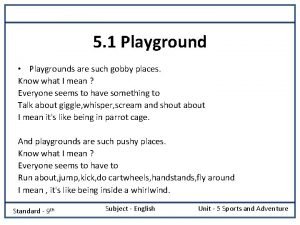Isamu Noguchis Utopian Landscapes The Sculpture of Playgrounds

- Slides: 1

Isamu Noguchi’s Utopian Landscapes The Sculpture of Playgrounds and Gardens Diana Witcher, Alex De. Armond, Sarah Diebel University of Wisconsin-Stout Isamu Noguchi (1904 -1988) • Innovative sculptor and designer most active in the 1960’s. • Inspired by his childhood in Japan, the high modernist movement and his involvement in the New York School of abstract artists (prominent in the 1930 s). • Noguchi’s work allows us to question the nature and definition of art and design. • Noguchi wanted to expand sculpture to move beyond the sole purpose of aesthetic, his was a sculpture for the common man. Playgrounds & Gardens as Sculpture (1933 -1988) • Lesser-know works are landscapes including playgrounds, monuments and Japanese inspired gardens. • Landscapes as a medium have inherent social value. Noguchi saw them as an artistic contribution to society. • Landscapes are a useful form of sculpture and can function as monuments, parks and playgrounds. Images: Top Left: Play Mountain. (1933). Bronze from original plaster. (Watz, 2009). Top Right: Riverside Park Playground. (1960). Bronze from original plaster. (Watz, 2009). Center Left: Acros Fukuoka Building (1995, Emilio Ambasz & Associates ). Fukuoka City, Japan. (Acros, 2009). Center Right: Sunken Garden, (1965 -1966). New York, New York. (Witcher, 2011). Bottom Left: Moere-numa Koen , (1988 -2004). Hokkaido, Japan. (Motoe, 2007). Bottom Center: Isamu Noguchi Garden Museum, (1975 -1988). Long Island City, New York. (Witcher, 2011). Bottom Right: Well, (1982). Long Island City, New York. (Witcher, 2011).

